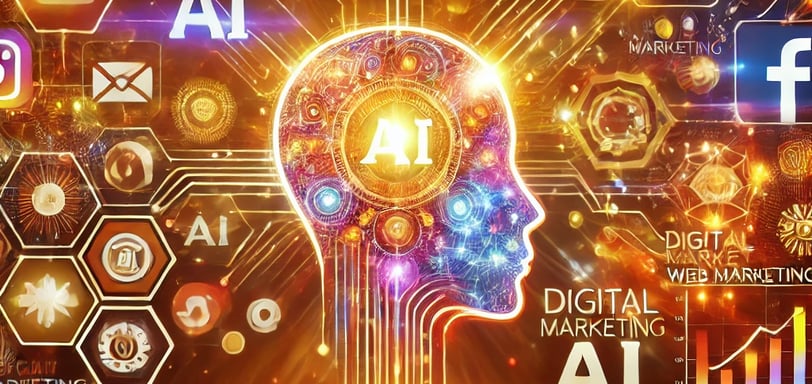How to Optimize Your Branding with AI and Web Marketing?
AI and web marketing are transforming branding, but how far without losing your identity? Learn how to combine advanced personalization, trend anticipation, and brand consistency for powerful and authentic strategic positioning. 🚀🔥
MARKETINGVEILLE MARKETINGWEBMARKETING
Lydie GOYENETCHE
2/1/20253 min read


How to optimize your Branding (image) with Web marketing and AI?
Brand Marketing in the Age of AI: Between Revolution and Subtlety
Brand Marketing is based on a subtle balance: differentiating yourself from the competition, capturing consumer trends and adapting your image in real time. In the past, companies relied on traditional market research, consumer panels, and industry reports to adjust their brand strategy. Today, artificial intelligence (AI) is disrupting these approaches. Capable of analyzing huge volumes of data in real time, it makes it possible to anticipate market developments, optimize communication and adjust the brand image with unparalleled responsiveness.
But is AI just a marketing tool or a factor in uprooting brand identities? Can we automate everything without altering the coherence of a brand? Far from abstract speeches, some companies have already integrated this technology strategically. Let's take a look at how AI is transforming brand marketing in concrete terms and what lessons can be learned to refine its positioning.
Starbucks and AI: when personalization becomes a signature
In the ultra-competitive world of coffee, Starbucks quickly realized that the quality of the coffee would not be enough to make a difference. Customer experience and loyalty have become the pillars of its positioning. To achieve this, the brand has implemented a frighteningly effective strategy by integrating AI into its loyalty program.
Its mobile application, used by nearly thirty million active customers, constantly analyzes consumer habits. Do you like caramel macchiato? The AI knows this and will offer you a discount on your next morning espresso before you even think about it. The objective: to anticipate needs and encourage repeat purchases.
But AI doesn't stop there. It also predicts stock needs per store, based on local trends and consumer habits. In this way, Starbucks reduces waste, improves product availability, and optimizes the customer experience. More than a coffee seller, Starbucks has become a connected brand, capable of creating a personalized connection with each customer.
McDonald's and AI: personalization without denial
Faced with the upheavals in the fast food sector, McDonald's has had to adapt its image and its products without betraying its DNA. Again, AI played a key role. Ordering kiosks, which are ubiquitous in restaurants, do not display the same menus for every customer or at every time of the day. During a heat wave, the AI highlights iced drinks. At peak times, it favours the quickest dishes to prepare to make the service more fluid.
AI also manages inventory, predicts influx, and optimizes customer flows. That's not all: by analyzing conversations on social networks, it identifies consumer expectations. That's how McDonald's developed the McPlant, anticipating the growing demand for plant-based alternatives.
Mc Donald's proves that AI can be used to make the offer more flexible and adapted without losing consistency. Standardization and personalization are not mutually exclusive, as long as you have a well-defined strategy.
AI at the service of Brand Marketing: analysis and anticipation
Artificial intelligence has become a real strategic lever for Brand Marketing. It makes it possible to analyze trends and anticipate market developments with formidable precision.
Tools such as Brandwatch, Sprinklr or Talkwalker scrutinize conversations on social networks in real time. They identify emerging trends, analyze consumer sentiment, and allow brands to adjust their communication even before the market changes.
A cosmetics manufacturer using Brandwatch, for example, can spot that a specific ingredient is becoming popular on Instagram. Rather than waiting for the trend to explode, he can quickly integrate this ingredient into his range and capture the market before his competitors.
Consistent branding thanks to well-managed AI
One of the great dangers of AI applied to branding is the risk of brand image fragmentation. Reacting too quickly to trends or over-personalizing your message can give the impression of incoherence. Brand identity should be a compass and not a boat tossed about by the waves of ephemeral trends.
A well-defined strategy involves setting immutable values and fundamentals while using AI to adjust the form of the message. Coca-Cola, for example, uses AI to optimize its advertising campaigns, but its message remains consistent: sharing and conviviality.
Finally, to ensure effective branding, AI must be accompanied by human oversight. Algorithms need to be adjusted, data analyzed critically, and branding aligned with a long-term vision. AI is not a compass, but an accurate map; It is still up to the human being to choose the destination.
Conclusion: AI, a tool, not a strategist
AI offers extraordinary opportunities for Brand Marketing: anticipating trends, optimizing the customer experience, advanced personalization. But it must remain a tool and not an end. A brand that forgets its identity by chasing every trend risks getting lost.
AI does not replace humans, it amplifies them. A strong brand is one that knows how to use technology while maintaining a clear strategic vision and an authentic relationship with its audience. The challenge is therefore to know when AI serves branding... and when it risks distorting it


EUSKAL CONSEIL
9 rue Iguzki alde
64310 ST PEE SUR NIVELLE
FRANCE
0033782505766
euskalconseil@gmail.com

